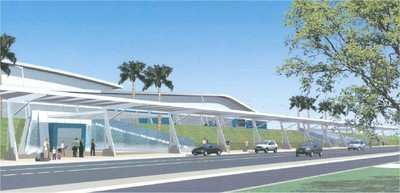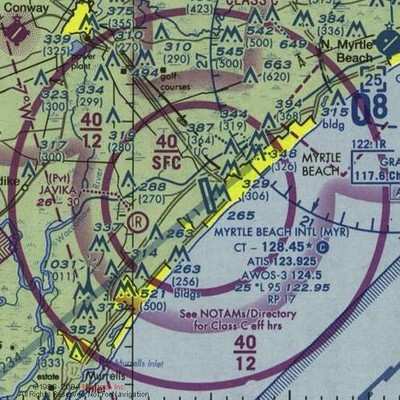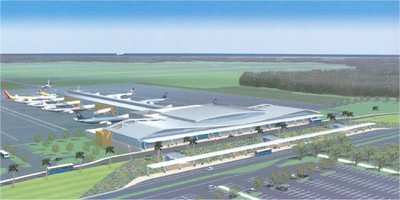Expansion Proposal Dashed Over Concerns About Nearby
Development
Eight years of hopes and plans to expand the Myrtle Beach International
Airport's seven-gate terminal were dashed Thursday,
when a volunteer city review board rejected those plans by a
unanimous vote.

The Community Appearance Board ultimately rejected the $229
million terminal after four months of intense workshops that
focused mainly on the building's physical appearance, saying a new
terminal would have been too close to a residential development on
the former Air Force Base next to the airport.
Over the next 10 years, thousands of new residents are expected
to inhabit the area... and a new terminal would create too many
problems with noise, floodlights and traffic, board members
said.
But, they "loved" the final look of the building and called it
"stunning," according to South Carolina's The Sun.
Stunned is a word that described many city and county officials
after the board's vote.
"I am still trying to breathe," County Council
Chairwoman Liz Gilland said. "I thought [board members] would
demand pretty extensive changes that might push it out of reach
financially. I just simply didn't expect them to vote it down -
until I got in there and started hearing how the meeting was
going."
 Over-crowding problems during
the airport's busy times will get worse, predicts County Attorney
John Weaver, who led the county's effort in front of the board.
There are currently no other plans for solving airport crowding,
such as expanding the existing terminal.
Over-crowding problems during
the airport's busy times will get worse, predicts County Attorney
John Weaver, who led the county's effort in front of the board.
There are currently no other plans for solving airport crowding,
such as expanding the existing terminal.
According to Weaver, the county will not appeal the decision in
court because it would likely draw out the project for years and
drive construction costs too high.
Elected officials are projecting doom and gloom for the
aftermath of this decision. It will likely hurt local governments'
chances of obtaining federal and state money in the future as well
as further damaging the "fragile" city/county relationship.
Future discussions won't happen anytime soon, said Gilland, who
has supported the project since its inception in 1999.
"I think for a long time we are going to do nothing," Gilland
said. "We'd have to go back before that same Community Appearance
Board, and it won't be while I'm chairman."
She added the new terminal was a "visionary answer" to growing
the local economy and moving Myrtle Beach and Horry County into the
future.
Since December, when the board first met, Horry County, which owns
and operates the airport, has been trying to get their approval.
All oceanfront residential and commercial construction projects
within the city limits must pass the board before developers can be
issued any permits.
Nearly $18 million has already been spent by the county on
architects, consultants, engineers and designers. Half this
amount came from the FAA, the other half from airport revenue,
Weaver said.
Just since January, the county spent more than $300,000 trying
to work with the board. Had the project been approved, the county
would have had to shell out an additional $600,000 finalizing the
plans and getting another price estimate, he said.
As for the city, Bruce Boulineau, construction services director
said, staff engineers spent about 219 hours working on the plans.
The rejection has decreased the city's chances of "getting favors
or concessions" from the county in the future and "will damage
relations" between the two entities, Myrtle Beach City Councilman
Randal Wallace said.
"It's gonna be chilly, to put it bluntly," he said. "I cannot
imagine this not upsetting them. I have already been hearing it
through back channels. ... [The board has] just undone a lot of the
good will between the city and the county, and they've known that
for four months."
"There are going to be repercussions from this that will last
for years," Gilland said. "It will affect funds coming our way from
D.C. We're not going to be on their radar screen for a while.
That's just the way it works."
At the last meeting, the board criticized the plan moving the
terminal from the east side to the west side of the runway and
questioned the financial sense in building a new terminal that
expanding the current one.
"How is that even remotely possible?" CAB Chairman Larry Bragg
said. "How could someone with a straight face do a report and say
it would cost the same amount of money to do something on the east
side as it would on the west?"

"My major concerns on this project is the enormous, adverse
impact this terminal will have on the surrounding residents," board
member Birgit Darby said. "The safety and health issues of the
people living in the area of this proposed terminal should be
uppermost in our minds. ... In good conscience, I cannot support
this project."
State Rep. Tracy Edge said this decision indicates it's time to
try another approach.
The North Eastern Strategic Alliance is a political and economic
development network that is currently sponsoring a study on a
regional airport for the area. NESA says a regional airport is one
of the key elements for the future of the region.

"I'm going to try to jump-start a regional airport authority and
approach it from that angle," said Edge. "There's no sense in
waiting any more."
 NTSB Final Report: Cozy Cub
NTSB Final Report: Cozy Cub ANN FAQ: Contributing To Aero-TV
ANN FAQ: Contributing To Aero-TV Classic Aero-TV: Seated On The Edge Of Forever -- A PPC's Bird's Eye View
Classic Aero-TV: Seated On The Edge Of Forever -- A PPC's Bird's Eye View ANN's Daily Aero-Linx (04.29.25)
ANN's Daily Aero-Linx (04.29.25) ANN's Daily Aero-Term (04.29.25): Execute Missed Approach
ANN's Daily Aero-Term (04.29.25): Execute Missed Approach






